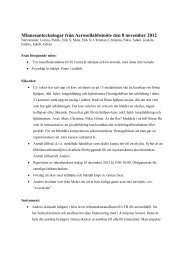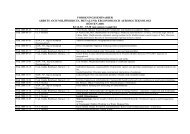ESTIMATING CLOUD DROPLET EFFECTIVE RADIUS ... - CAST
ESTIMATING CLOUD DROPLET EFFECTIVE RADIUS ... - CAST
ESTIMATING CLOUD DROPLET EFFECTIVE RADIUS ... - CAST
- No tags were found...
Create successful ePaper yourself
Turn your PDF publications into a flip-book with our unique Google optimized e-Paper software.
<strong>ESTIMATING</strong> <strong>CLOUD</strong> <strong>DROPLET</strong> <strong>EFFECTIVE</strong> <strong>RADIUS</strong> FROM SATELLITE REFLECTANCE DATAModified Exponential Approximation___________________________________________________________________________________________________corresponds to the 0.865 µm wavenband (Kokhanovsky, 2006)According to Kokhanovsky et al. (2006, unpublished) the accuracy of r e is strongly dependenton the correct information with respect to cloud fraction. One can expect r e to beoverestimated if retrieved over broken cloud field, due to unknown contribution from theground. However, the larger the optically thickness, the smaller the contribution from theground, and even more so if the 0.65 µm waveband is used instead of the 0.865 µmwaveband. From the different error analysis conducted in the studies by Kokhanovsky et al.the overall error is estimated to be in the range 5-20%, depending on viewing geometry andcloud optical thickness.5. CONCLUSIONSThe results from the four runs show that the modified exponential approximation can be usedwith relatively high accuracy on satellite data under certain conditions. The model is restrictedto optically thick clouds where τ > 10 (5 if only a first order estimation is required). However,since the optical thickness is not previously known but computed in the model, the conditionsmust be given in terms of reflectance. The results from the two first runs where R 2 > 0.2(0.25)showed relatively high values of effective radius and low values of optical thickness (τ < 5),which confirms that low reflectance values indicate optically thin clouds, thus making theresults less reliable.The model performed well (in relation to what was expected) where R 2 > 0.3, for both τ > 10and τ > 5. The median effective radius of 14.6 µm was high in comparison to the results fromcontinental clouds (9 µm) in the study by Rosenfeld and Lensky (1998). However, the resultis rather similar to the near coastline clouds, which had a median effective radius of 14 µm.A reason for this difference may lie in the geographical differences. The highly continentalclouds studied by Rosenfeld and Lensky (1998) was located over southern Malaysia andcentral Sumatra, a much larger area with dense population and likely more air pollution thanover the forests of southern Sweden. From this aspect, the “continentality” of southernSweden area is not comparable to the same of Malaysia and Sumatra, and it would perhaps bemore relevant to compare the results from southern Sweden with the near coastline clouds.The model has been validated against numerical methods in a few studies. The validation byNauss et al. (2005) showed that the approximate model, despite its simplicity, tended toproduce results comparable to results from conventional methods (numerical methods, LUT).The error varies from 5 to 20%, depending on which wavebands that are used, viewinggeometry and pixel resolution. The studies stress the importance of fully cloud covered pixelsfor good results, and good knowledge about ground surface albedo where the cloud cover isbroken, or where clouds are optically thin. This is even more important when usingwavebands sensitive to ground surface reflectance. However, in this study the wavebandsused were chosen to minimize the influence by the underlying surface.The model is fast, simple and straight forward, which is an advantage if the purpose is tounderstand the processes involved in cloud formation. The aim of the study was to produce amodel that can be used together with cloud top temperatures to study changes in the verticalprofile of the cloud, induced by aerosols. In this case, exact values of the cloud droplet radiusare perhaps not essential, but rather the ability to study differences and changes, and to do so24




